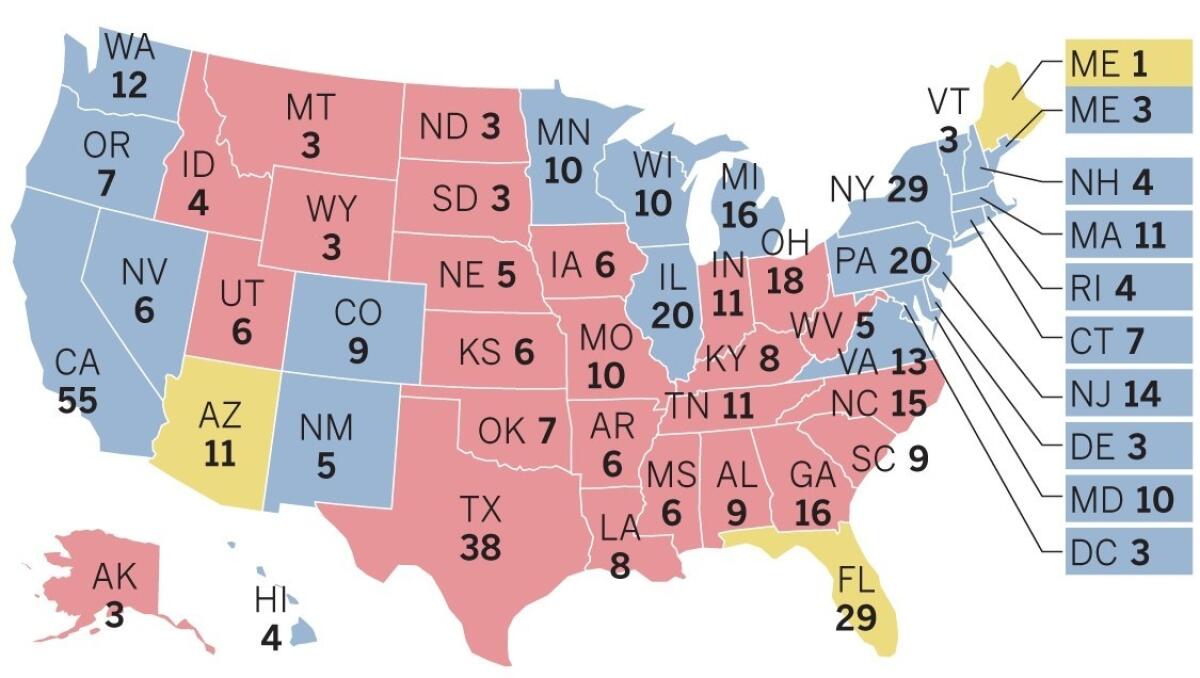Election turnout broke records, and as the count continues, Democrats’ prospects improve
Reporting from Washington — Across the country, from Florida to California, millions of ballots remain to be counted from an election that broke turnout records, and as the count continues, Democratic wins have mounted.
Republicans in Florida and Georgia have begun warning ominously about the threat of vote fraud as they watch Tuesday-night victory margins shrink. There’s been no evidence of that, however, just the slow processing of votes from an election that, nationwide, may have broken a century-old turnout record.
Republicans fear losing two Senate seats that on Tuesday night they thought they had won. Democrats’ gains in the House have expanded. That worsens the outlook for President Trump in 2020, given the states in which Democrats won this year.
Sign up for the Essential Politics newsletter »
A DANGEROUS ELECTORAL MAP FOR TRUMP
Voters swung heavily toward the Democrats this year, and that poses a big challenge for Trump as he looks toward reelection.
Here’s a map showing how electoral votes would be distributed based on which party prevailed on Tuesday. A Democrat would win the presidential contest on this map with 278 electoral votes, eight more than needed for a victory, versus 219 for the Republican and 41 tossups.

I allocated the states in most cases by which party won the top statewide race or, if there wasn’t a race for Senate or governor, by which party got the largest number of votes for Congress. I awarded Iowa to the Republicans, since Gov. Kim Reynolds won statewide, even though Democrats won more congressional votes. I also left Kansas in the GOP column although Democrat Laura Kelly won the governor’s race; Republicans won the congressional vote in that state.
I’ve listed Arizona, Florida and Maine’s 2nd Congressional District as tossups, since the races there remain unresolved. Maine is one of two states that awards electoral votes by district, rather than entirely statewide.
Obviously, this doesn’t mean Trump will definitely lose his reelection. The 2020 campaign won’t simply replicate 2018.
But it does highlight two key takeaways from this week:
- Trump’s strategy of polarizing the electorate remains a high-risk play, as I wrote on election night.
- And the election will probably be decided once again in the big industrial states of the Midwest and mid-Atlantic.
Trump secured his 2016 victory with narrow wins in Pennsylvania, Michigan and Wisconsin. All three of those states swung back heavily toward the Democrats this year.
The Democratic gains were powered by women and younger voters, as Mark Barabak and I wrote.
Democratic victories were especially concentrated in suburban districts. In the big three swing states, that means the counties outside Philadelphia, Pittsburgh and Detroit, as well as the heavily Republican suburbs outside Milwaukee, where GOP margins were significantly smaller than usual, sealing the defeat of Gov. Scott Walker.
Republicans did well in Ohio, even though the state reelected Democratic Sen. Sherrod Brown. Florida is seemingly always a tossup. And Democrats’ hopes that they can swing Arizona remain unproven.
But a Democratic presidential candidate doesn’t need to win any of those states to prevail if he or she can win back the three big Midwestern and mid-Atlantic states that Trump won.
The question for the next two years will be whether Democrats can keep the loyalty of those suburban voters they won this year and still maintain the enthusiasm of their more liberal voters in the cities. If they can, Trump will be in deep trouble, despite his continued hold on his rural base.
BIG TURNOUT, LONG COUNT
Nationwide, at least 114 million people, 48.5% of the voting-eligible population, cast ballots in this year’s midterm elections, according to Michael McDonald of the University of Florida, the country’s leading expert on voter turnout.
That would be the highest turnout in more than half a century. And the total may go higher yet, McDonald says, surpassing the level set in 1966, before the voting age was lowered to 18, and challenging the record set in 1914, before most women had the right to vote.
In many states, that’s left big piles yet to be counted, primarily mail-in and provisional ballots. California’s secretary of state’s office estimated on Thursday that almost 4.5 million votes remained to be tallied statewide, 1.4 million of them in Los Angeles and Orange counties. About 7.3 million ballots have already been counted in the state.
As Michael Finnegan reported, in California, early-arriving ballots almost always favor Republicans and late-arriving ballots typically favor Democrats. That’s largely because younger voters tend to send in their ballots at the last minute, and they tend to vote Democratic.
So far, two Republican-held congressional seats in the state, the 49th District straddling San Diego and Orange counties, and the 25th in northern Los Angeles County, have flipped to the Democrats. At least two more, and perhaps as many as four, could flip in the final count.
California counties have until Dec. 7 to report their final counts.
In Arizona, more than 400,000 ballots remain, about one in six of the statewide vote. On Thursday, Democrat Rep. Kyrsten Sinema took a lead of about 9,000 votes over Republican Rep. Martha McSally in the race for U.S. Senate. Political experts in that state say they can only guess which side the remaining ballots will favor.
In Arizona, the final ballots won’t be counted until next week at the earliest.
And in Florida, Republicans lead in both of the state’s top races, for governor and Senate, but the margins have shrunk dramatically since Tuesday night. Gov. Rick Scott now leads incumbent Sen. Bill Nelson by 0.18 percentage points, or just over 15,000 votes, of more than 8.1 million cast. An uncertain number remain to be tallied, mostly in Broward County in South Florida, which is a Democratic stronghold.
In the race for governor, Rep. Ron DeSantis, the Republican, leads Tallahassee Mayor Andrew Gillum by 0.44 points.
Both races are currently close enough to trigger the state’s mandatory recount law, and the Senate race is close enough to require a hand recount of ballots. Florida counties have until Saturday to report their final results, after which state officials would begin the recount process.
Finally, in Georgia, the issue is whether Republican Brian Kemp has enough votes to avoid a runoff against Democrat Stacey Abrams. Kemp has about a 63,000-vote lead over Abrams, but state law requires a runoff if no candidate gets over 50%. Because of a third-party candidate, Kemp is barely above that line currently.
Abrams campaign officials say they believe that, as final ballots are counted, Kemp will drop below 50%.
A BIGGER WIN FOR DEMOCRATS
On election night, Democrats won control of the House, but feared they had lost five Senate elections they had hopes of winning, as well as the Florida and Georgia governors races.
But with Sinema now leading in Arizona, and Nelson catching up in Florida, it’s possible that Republicans may have won only three of those five — defeating incumbent Democrats in North Dakota, Missouri and Indiana. Republicans lost the Senate seat held by Sen. Dean Heller in Nevada.
So far, Republicans have won 51 Senate seats, which is where they stood before the election. They’ll very likely win a runoff in Mississippi between Sen. Cindy Hyde-Smith and Democratic candidate Mike Espy, giving them 52.
If that’s all they get, it would largely belie the claim Trump made in his long and grievance-filled news conference on Wednesday that he had led his party to a major victory in the Senate.
On the House side, the Democrats on election night seemed on track to pick up at least 30 seats. So far, they’ve nailed down 31. With a dozen races left uncalled, they’re likely to end up with a net gain of 37 or 38 seats, based on the returns so far.
In both chambers, the final numbers are likely to challenge the narrative that emerged on election night of a somewhat disappointing Democratic win. In the full light of day, the party’s victory seems considerably more impressive.
The overall Democratic margin in House votes nationwide came to about seven percentage points. In 2016, Democrats lost the total House vote by one point. That eight-point swing marks one of the biggest shifts from one party to the other since World War II.
THE END OF THE OBAMACARE WAR
One result of this election will probably be to end the long Republican effort to repeal Obamacare, Noam Levey wrote. With Democrats in control of the House, no repeal measure will come to the floor, and in the Senate, Majority Leader Mitch McConnell of Kentucky has shown no interest in jumping back into the fight.
Republicans repeatedly promised on the campaign trail to keep the law’s protections for people with preexisting health problems, locking in one major provision of the law that they had tried to repeal. And voters approved referendums to expand Medicaid under the law in Idaho, Nebraska and Utah, all conservative states.
AND THE END FOR JEFF SESSIONS
Trump wasted no time in firing his attorney general, who was one of his earliest and strongest supporters, but who angered the president by not blocking the investigation into Russian efforts to sway the 2016 election.
Democrats hope to use their new power in the House to try to protect the Russia investigation, led by special counsel Robert S. Mueller III, as Chris Megerian and Del Wilber reported.
Rep. Adam Schiff of Burbank, who is in line to regain the chairmanship of the House Intelligence Committee, says he wants to determine if Russians have “financial leverage” over the president by laundering money through the Trump Organization.
“There’s nothing the president cares more about than his wealth,” Schiff said.
BUT A CONTINUED FIGHT OVER IMMIGRATION
Trump on Friday issued a proclamation designed to sharply restrict the ability of people to seek asylum in the U.S.
As David Savage and Noah Bierman wrote, the move is certain to be challenged in court. Administration officials believe the Supreme Court, with its newly strengthened conservative majority, will side with them both on the asylum issue and on a separate case involving their efforts to end the Obama-era DACA program, which shields some 700,000 people from deportation.
WHAT THE ELECTION MEANS FOR CALIFORNIA
Newly elected Gov. Gavin Newsom is expected to intensify the state’s battle with the Trump administration, Melanie Mason wrote.
“It’s been a long two years, but tonight, America’s biggest state is making America’s biggest statement,” Newsom said on election night. “We are saying, unmistakably and in unison, that it’s time to roll credits on the politics of chaos and cruelty.”
Here’s where Newsom stands on a wide range of issues.
As Mason noted, one constraint on the new governor is that the federal government plays a key role in many issues important to the state, including water supply and money for disaster aid. All-out conflict would carry a heavy price.
A central issue for Newsom will be how far to the left he wants to try to lead the state, John Myers wrote. Newsom will face pressure from Democratic Party activists, who typically are more liberal than the state’s voters.
But he’s also had the benefit of watching Gov. Jerry Brown as he spent the last eight years backing progressive causes on some fronts while restraining others, especially on policies that would have significantly boosted state spending.
Newsom has said he would take another look at California’s rent-control policies as part of an overall effort to try to deal with the state’s extremely high housing costs. As Liam Dillon reported, the statewide ballot measure to expand rent control failed, but advocates plan to continue to press the issue.
The newly elected Democratic House and seven new Democratic governors will give California important allies on many of the issues on which the state has been fighting the administration, Evan Halper reported.
PELOSI, MCCARTHY LIKELY LEADERS
The leaders of both parties in the House could be from California, although both Reps. Nancy Pelosi of San Francisco and Kevin McCarthy of Bakersfield face some opposition in their caucuses.
As Jennifer Haberkorn wrote, many Democrats want to see a generational shift in their leadership. Pelosi has expressed confidence that she has the votes to regain the speaker’s office, and leading her party to victory gives her a strong claim. But several newly elected Democrats said during their campaigns that they would not vote for her.
McCarthy has an easier path to the leadership of his party in the House, now that it will be in the minority, Sarah Wire reported. Had the Republicans kept the majority, conservatives would have tried to beat him, but the minority leader’s post is less attractive.
In their statements on Wednesday, Pelosi and Trump warily circled each other, offering olive branches, but also setting conditions, Haberkorn and Eli Stokols wrote.
A MORE DIVERSE HOUSE
The Democratic victories bring with them a big increase in the number of women in Congress, Wire reported. At least 99 women will serve in the new Congress, up from 84, and the number will probably be higher as the final races are called.
The new House will include the first two Muslim and Native American women elected as well as the first Latina from Texas and the first African American woman from Massachusetts.
Women are on track to make up nearly 40% of House Democrats in 2019, but less than 7% of House Republicans.
In the Senate, the number of women will tick up to 24 from the current 23, at least seven Republicans and 16 Democrats, plus whichever candidate wins in Arizona.
LOGISTICS
That wraps up this week. Until next time, keep track of all the developments in national politics and the Trump administration with our Essential Washington blog, at our Politics page and on Twitter @latimespolitics.
Send your comments, suggestions and news tips to [email protected].
If you like this newsletter, tell your friends to sign up.
More to Read
Get the L.A. Times Politics newsletter
Deeply reported insights into legislation, politics and policy from Sacramento, Washington and beyond. In your inbox three times per week.
You may occasionally receive promotional content from the Los Angeles Times.











